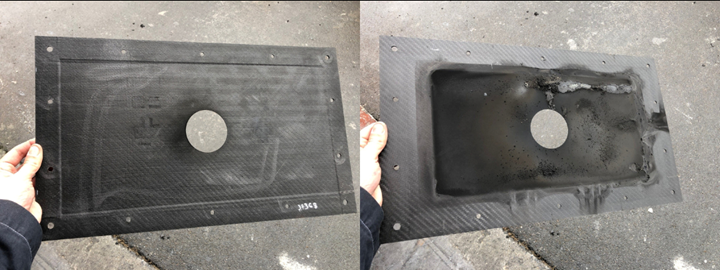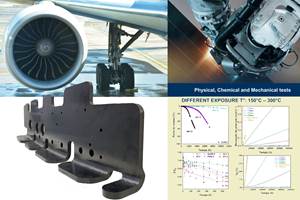Pyromeral mineral composites demonstrate resistance to thermal runaway
PyroKarb, a carbon fiber-reinforced glass-ceramic, has been demonstrated to withstand the high temperatures of open flame during a thermal runaway event in eVTOL batteries with little to no damage.
PyroKarb plate face before battery thermal runaway testing (left) and after testing (right). Note that the material on the right shows no physical degradation, only molten particles or soot bonded on the surface. Photo Credit: Pyromeral
Pyromeral Systems (Barbery, France) specializes in the development and manufacture of heat-resistant mineral composites. PyroKarb, Pyromeral’s class of carbon fiber-reinforced glass-ceramic composite materials, for example, are well suited for the production of lightweight parts that operate at low temperatures in normal conditions, but require resistance to flames at very high temperatures, a situation most commonly experienced by thermal runaway in battery enclosures, or from burning kerosene.
Unlike carbon fiber-reinforced polymers (CFRP), PyroKarb composites are reported to be completely incombustible with a low density of 1.65 kg/dm3. Pyromeral says they do no release any smoke or harmful gases when exposed to elevated temperatures and successfully comply with the most stringent fire safety requirements.
Pyromeral has proven these characteristics through several tests. In one demonstration PyroKarb composite with a minimum thickness of 0.6 millimeter was exposed to a kerosene flame (1,070-1,100°C) for 15 minutes without the flame traveling, nor was there fumes or smoke (see the kerosene flame test here). Pyromeral noted loss of some of the material’s mechanical properties — specifically, its tensile strength dropped from 250 MPa to 40 MPa — but the material was virtually untouched.
In recent years, Pyromeral has tested its material against electric vertical takeoff and landing (eVTOL) aircraft battery casings as a potential fire protection solution and as an additional opportunity to save weight on the aircraft — typically, eVTOL batteries weigh more than one ton. As PyroKarb materials resist well against FAA-AC 20-135 tests, it made sense to contribute it to the protection of eVTOL vehicles and its passengers in case of thermal runaway.
CREPIM Laboratory (Bruay-la-Buissière, France) was consulted to lead Pyromeral’s battery ignition resistance tests to demonstrate’s PyroKarb’s capacity for eVTOL applications. Tests have been performed on a thin PyroKarb cover (0.9 millimeter thick) on a metallic rack using eight connected lithium-ion battery cells, each with 185 watt-hours of power and 51 amp-hours of capacity. Thermal runaway was generated using a 600-watt heating pad, which heated the cover to 925°C. An aperture was made in the center of the PyroKarb plate to enable fume and particle evacuation.
At the test’s conclusion, the PyroKarb cover did not show any wear or damage. Only surface pollution was visible. Mechanical tests were performed on both control samples and heat-affected areas. The company reported no impact on mechanical properties after the fire test (tensile modulus of 75 GPa and tensile resistance comprised between 195-220 MPa). Thus, the demonstration proved to Pyromeral the composite material’s capacity to survive well during a thermal runaway event, meaning it could be considered as a structural material for battery casing.
What’s next for the company? “Pyromeral plans to increase material quantities per the demand of end-use partners, while implementing two new prepreg production lines, the first one being installed in its European factory (in France), and the second one being in a new production facility in the U.S. (California),” Dr. Ing. Guillaume Jandin, sales and marketing director, Pyromeral, says. “The U.S. facility will also incorporate a design office and composite component production capacities. Both lines will be in operation before the end of this year. They could each produce approximately ~50,000 square meters (>500,000 square feet) of prepreg per year. A third machine will be prepared to enter production in 2025.”
Related Content
JEC World 2023 highlights: Innovative prepregs, bio-resins, automation, business development
CW’s Jeff Sloan checks in with JEC innovations from Solvay, A&P, Nikkiso, Voith, Hexcel, KraussMaffei, FILL, Web Industries, Sicomin, Bakelite Synthetics, Westlake Epoxy and Reliance Industries.
Read MoreParis Air Show 2023 highlights
The Paris Air Show, one of the largest aerospace trade shows in the world, returned for the first time since 2019 and proved that the global aviation industry industry is very much alive and kicking.
Read MoreDaher CARAC TP project advances thermoplastic composites certification approach
New tests, analysis enable databases, models, design guidelines and methodologies, combining materials science with production processes to predict and optimize part performance at temperatures above Tg (≈150-180°C) for wing and engine structures.
Read MoreTU Munich develops cuboidal conformable tanks using carbon fiber composites for increased hydrogen storage
Flat tank enabling standard platform for BEV and FCEV uses thermoplastic and thermoset composites, overwrapped skeleton design in pursuit of 25% more H2 storage.
Read MoreRead Next
Composites end markets: Energy (2024)
Composites are used widely in oil/gas, wind and other renewable energy applications. Despite market challenges, growth potential and innovation for composites continue.
Read MoreCW’s 2024 Top Shops survey offers new approach to benchmarking
Respondents that complete the survey by April 30, 2024, have the chance to be recognized as an honoree.
Read MoreFrom the CW Archives: The tale of the thermoplastic cryotank
In 2006, guest columnist Bob Hartunian related the story of his efforts two decades prior, while at McDonnell Douglas, to develop a thermoplastic composite crytank for hydrogen storage. He learned a lot of lessons.
Read More



























